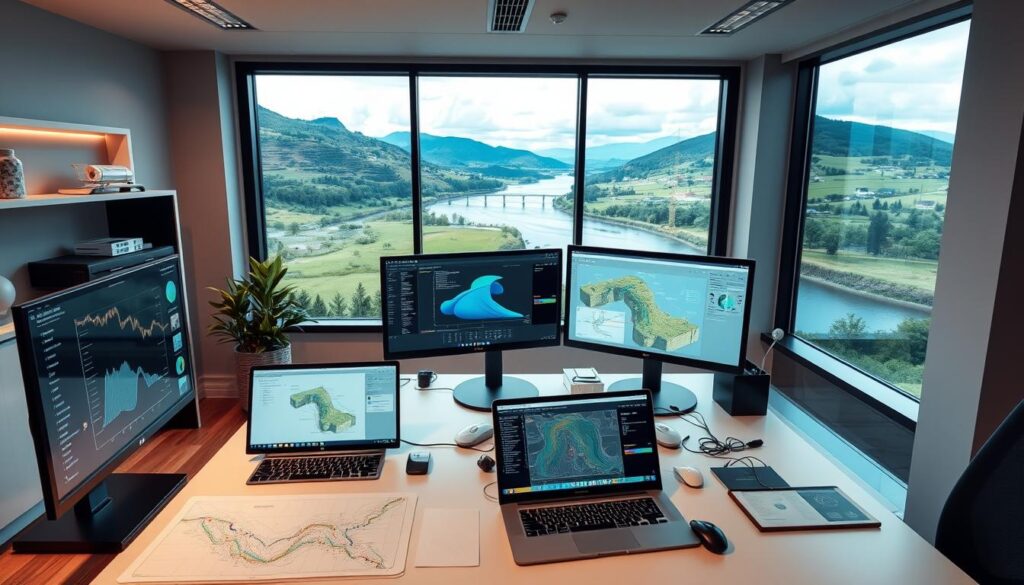Are you aware of the most effective ways to manage water resources sustainably in today’s challenging environmental landscape? As the world grapples with increasing water scarcity and infrastructure demands, water engineering software tools have become indispensable for professionals in the field.
These advanced tools enable environmental engineers and water sector professionals to design, manage, and optimize water systems efficiently. By leveraging cutting-edge technology, such as those used in civil engineering project management, water engineering professionals can now tackle complex challenges with greater precision and effectiveness.
Key Takeaways
- Understanding the role of water engineering software tools in sustainable water management.
- Identifying key features of effective water engineering software.
- Recognizing the benefits of using advanced tools in water engineering projects.
- Exploring the integration of water engineering software with other technologies.
- Assessing the impact of these tools on environmental sustainability.
Understanding Water Engineering Software Tools
Understanding the capabilities of water engineering software is crucial for effective water management. These tools have become indispensable in managing water resources efficiently.
Definition and Overview
Water engineering software encompasses a range of tools used for water resources management, including GIS and Remote Sensing, hydrological modeling, and hydraulic engineering software. These tools help professionals analyze, design, and manage water infrastructure projects.
The use of water resources management software has streamlined processes, making it easier to handle complex data and simulations. This software is designed to support decision-making in water management by providing accurate and reliable data.
Importance in Water Management
The importance of water engineering software lies in its ability to enhance the planning, design, and operation of water management systems. Hydraulic modeling software, for instance, allows for the simulation of various scenarios, helping to predict and mitigate the effects of floods or droughts.
For more information on the software used in water resources management, you can visit the USGS Water Resources Software page, which provides valuable resources and tools for professionals in the field.
By leveraging these advanced tools, professionals can improve the efficiency and sustainability of water management practices, ultimately contributing to better conservation and utilization of water resources.
Key Features of Water Engineering Software

Water system design software and hydrological analysis tools are vital components of modern water engineering, offering a multitude of benefits. These tools have revolutionized the way professionals design, manage, and analyze water systems.
User-Friendly Interface
A user-friendly interface is crucial for the adoption and effective use of water engineering software. Tools like AutoCAD Civil3D and EPANET are renowned for their intuitive interfaces, which simplify complex tasks and reduce the learning curve for new users.
Key benefits of a user-friendly interface include:
- Increased productivity
- Reduced training time
- Enhanced user experience
Data Analysis Capabilities
Advanced data analysis capabilities are a hallmark of effective water engineering software. These capabilities enable professionals to analyze complex data sets, model various scenarios, and make informed decisions.
“The ability to analyze data effectively is crucial in water engineering, as it allows professionals to predict and mitigate potential issues.” –
Software tools with robust data analysis capabilities can handle large datasets, perform statistical analysis, and visualize results in a meaningful way.
Integration with GIS Systems
Integration with Geographic Information Systems (GIS) is another key feature of modern water engineering software. This integration enables professionals to analyze and visualize spatial data, enhancing the accuracy of their designs and analyses.
| Software | GIS Integration | Data Analysis | User Interface |
|---|---|---|---|
| AutoCAD Civil3D | Yes | Advanced | User-Friendly |
| EPANET | Yes | Advanced | User-Friendly |
| HEC-RAS | Yes | Advanced | User-Friendly |
Popular Water Engineering Software Tools
In the realm of water engineering, several software tools have gained popularity for their ability to enhance project efficiency and accuracy. These tools are designed to meet the complex demands of water infrastructure design, analysis, and management.
AutoCAD Civil3D
AutoCAD Civil3D is a powerful tool used extensively in civil infrastructure design, including water infrastructure projects. It offers a comprehensive set of features for designing, analyzing, and implementing infrastructure projects. Its capabilities include:
- Detailed site design and analysis
- Advanced grading and corridor modeling
- Hydrology and hydraulics analysis
For instance, a water engineering firm might use AutoCAD Civil3D to design a new water treatment plant, leveraging its capabilities for site design and hydrology analysis to ensure the project’s feasibility and compliance with regulations.
EPANET
EPANET is a widely used software tool developed by the EPA for water distribution modeling. It allows engineers to analyze and simulate water distribution systems, predicting water quality and hydraulic behavior under various conditions. EPANET is particularly useful for:
- Modeling water distribution networks
- Analyzing water quality and hydraulic behavior
- Optimizing system performance and energy consumption
EPANET’s capabilities make it an indispensable tool for water utilities and engineering firms tasked with ensuring the reliability and efficiency of water distribution systems. For more information on water resources management tools like EPANET, visit GoldSim’s Water Resources page.
HEC-RAS
HEC-RAS, developed by the US Army Corps of Engineers, is a software tool used for river hydraulics and floodplain studies. It enables engineers to perform detailed river analysis, including steady and unsteady flow simulations, sediment transport modeling, and floodplain delineation. HEC-RAS is crucial for:
- Analyzing river hydraulics and flood risk
- Modeling sediment transport and river morphology
- Designing flood control measures and river restoration projects
The use of HEC-RAS has become a standard practice in flood risk assessment and river engineering projects, helping to mitigate flood risks and protect communities.
| Software Tool | Primary Application | Key Features |
|---|---|---|
| AutoCAD Civil3D | Civil Infrastructure Design | Site design, grading, corridor modeling, hydrology analysis |
| EPANET | Water Distribution Modeling | Network modeling, water quality analysis, hydraulic simulation |
| HEC-RAS | River Hydraulics and Floodplain Studies | River analysis, flood risk assessment, sediment transport modeling |
As highlighted by industry experts, “The integration of advanced software tools like AutoCAD Civil3D, EPANET, and HEC-RAS into water engineering practices has revolutionized the field, enabling more accurate and efficient project execution.” The continued adoption and development of these tools will be crucial in addressing the complex challenges facing the water engineering sector.
Applications of Water Engineering Software
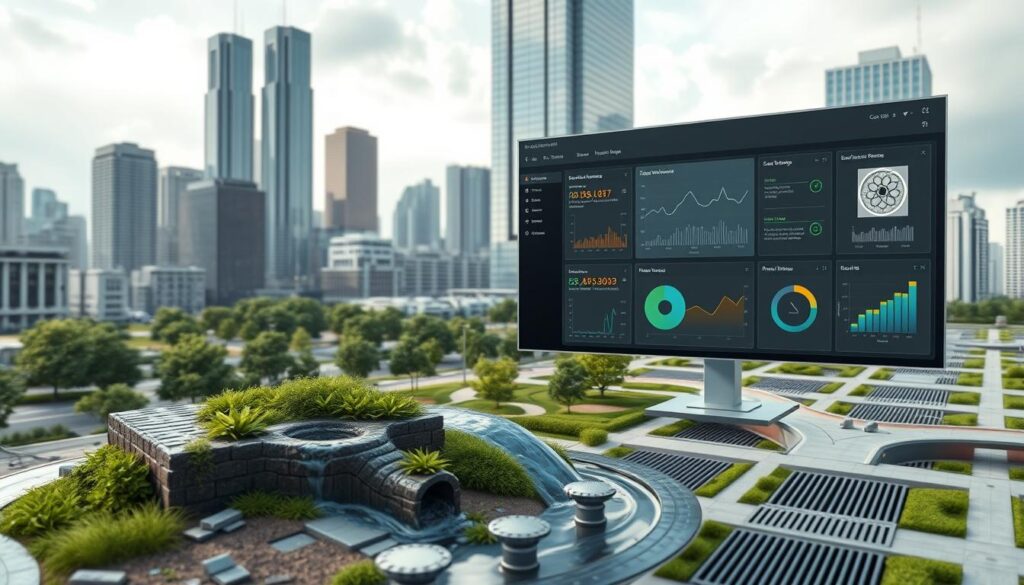
Water engineering software is revolutionizing the way we manage water resources, from urban planning to flood risk assessment. These tools are designed to address complex water management challenges, providing effective solutions for various applications.
Urban Water Management
Urban water management is a critical application of water engineering software. These tools help in designing and managing urban drainage systems, mitigating the risk of urban flooding, and ensuring that water resources are utilized efficiently. Stormwater management software is particularly useful in this context, enabling professionals to model and simulate different stormwater management scenarios.
Flood Risk Assessment
Flood risk assessment is another vital application of water engineering software. By using advanced modeling and simulation capabilities, these tools help in identifying flood-prone areas, assessing the risk of flooding, and developing strategies to mitigate flood risks. This is crucial for protecting communities and infrastructure from the devastating effects of floods.
Water Distribution Modeling
Water distribution modeling is essential for ensuring that water is distributed efficiently and safely. Water engineering software provides the capability to model water distribution systems, helping professionals to optimize system performance, detect potential issues, and plan for future expansions or upgrades.
By leveraging these applications, water engineering software contributes significantly to effective water management practices, enhancing the resilience of water infrastructure and supporting sustainable development.
Benefits of Using Water Engineering Software
The adoption of water engineering software has revolutionized the field of water management by providing professionals with advanced tools to design, analyze, and manage water treatment projects more effectively. Water treatment plant design software is a prime example of such tools, offering a range of benefits that enhance project execution.
Increased Efficiency
One of the primary benefits of using water engineering software is the significant increase in efficiency it brings to project execution. By automating complex calculations and providing real-time data analysis, these tools enable professionals to complete tasks more quickly and accurately. For instance, water treatment plant design software can streamline the design process by allowing engineers to simulate different scenarios, thereby reducing the time required for project completion.
Improved Accuracy
Water engineering software also improves the accuracy of designs and analyses. By minimizing manual calculations and reducing the potential for human error, these tools ensure that projects are executed with a high degree of precision. The use of advanced algorithms and data analysis capabilities in software like water treatment plant design software further enhances accuracy, leading to better project outcomes.
Enhanced Collaboration
Another key benefit of water engineering software is its ability to enhance collaboration among stakeholders. By providing a centralized platform for data sharing and project management, these tools facilitate communication and coordination among team members. This is particularly beneficial in large-scale water treatment projects where multiple stakeholders are involved, ensuring that all parties are aligned and working towards the same objectives.
In conclusion, the benefits of using water engineering software, including increased efficiency, improved accuracy, and enhanced collaboration, make it an indispensable tool in modern water management. By leveraging these tools, professionals can achieve better project outcomes and contribute to more effective water resource management.
Criteria for Evaluating Water Engineering Software
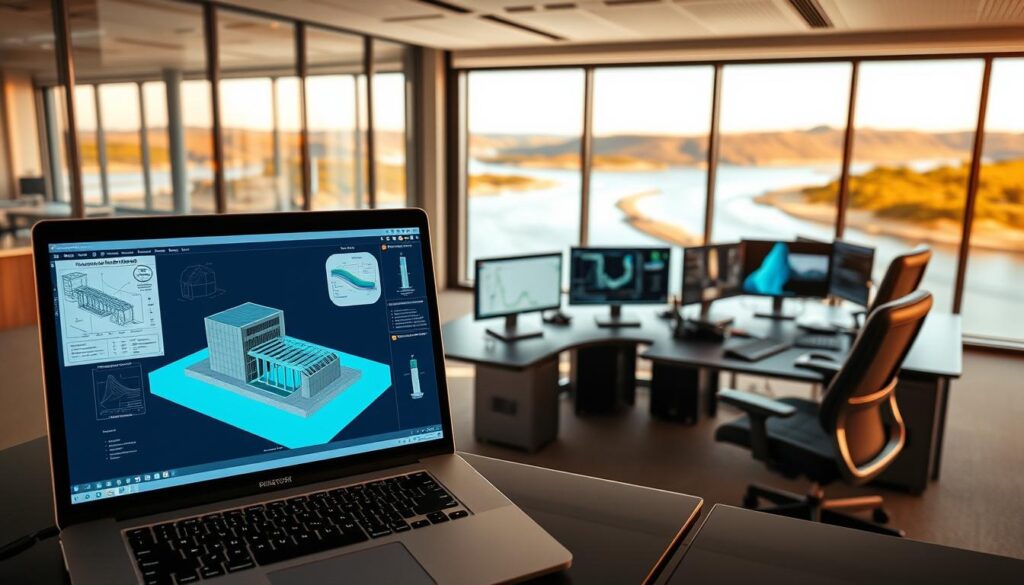
Evaluating water engineering software involves a comprehensive assessment of various critical criteria. Professionals must consider several key factors to ensure the selected software meets their project’s specific needs and enhances their workflow.
Technical Support and Training
One of the crucial factors in evaluating water engineering software is the level of technical support and training provided. Reliable technical support ensures that any issues are resolved promptly, minimizing downtime and maintaining productivity. Moreover, comprehensive training programs enable users to maximize the software’s capabilities, including advanced features such as wastewater modeling tools.
Cost vs. Features
Another significant consideration is the balance between the cost of the software and its features. Cost-effectiveness is crucial, as it directly impacts the project’s budget. Professionals must weigh the benefits of advanced features against the additional costs, ensuring that the chosen water engineering software tools provide the necessary functionality without exceeding budget constraints.
User Reviews and Ratings
User reviews and ratings offer valuable insights into the performance and reliability of water engineering software. By examining feedback from existing users, professionals can gain a better understanding of the software’s strengths and weaknesses. This information is instrumental in making an informed decision, helping to select software that meets their specific requirements and expectations.
In conclusion, evaluating water engineering software requires a thorough assessment of technical support, cost versus features, and user reviews. By carefully considering these criteria, professionals can select the most appropriate software for their needs, enhancing their ability to manage water engineering projects effectively.
Emerging
Emerging trends in hydraulic modeling software are revolutionizing the field by providing more efficient, accurate, and sustainable solutions.
Cloud-Based Solutions
Cloud-based solutions are becoming increasingly popular in water engineering software due to their flexibility and scalability. These solutions allow professionals to access their projects from anywhere, facilitating collaboration and remote work.
Key benefits of cloud-based solutions include:
- Enhanced collaboration
- Scalability to meet project demands
- Reduced need for on-premise infrastructure
AI and Machine Learning Integration
The integration of Artificial Intelligence (AI) and Machine Learning (ML) in water engineering software is transforming the way professionals analyze data and make predictions. AI and ML algorithms can process vast amounts of data quickly, identifying patterns that may not be apparent to human analysts.
For instance, AI can be used for:
- Predictive modeling of water distribution systems
- Automated detection of anomalies in water quality
- Optimization of water treatment processes
Sustainability Features
Sustainability is becoming a critical aspect of water engineering software. Modern tools are being designed with features that help professionals assess and minimize the environmental impact of their projects.
A comparison of traditional vs. modern water engineering software in terms of sustainability features is shown below:
| Feature | Traditional Software | Modern Software |
|---|---|---|
| Environmental Impact Assessment | Limited | Comprehensive |
| Energy Efficiency Analysis | Not Available | Available |
| Water Conservation Tools | Basic | Advanced |
As the field continues to evolve, we can expect to see even more innovative solutions emerge, further enhancing the capabilities of water engineering professionals.
Top Industry-Specific Water Engineering Solutions
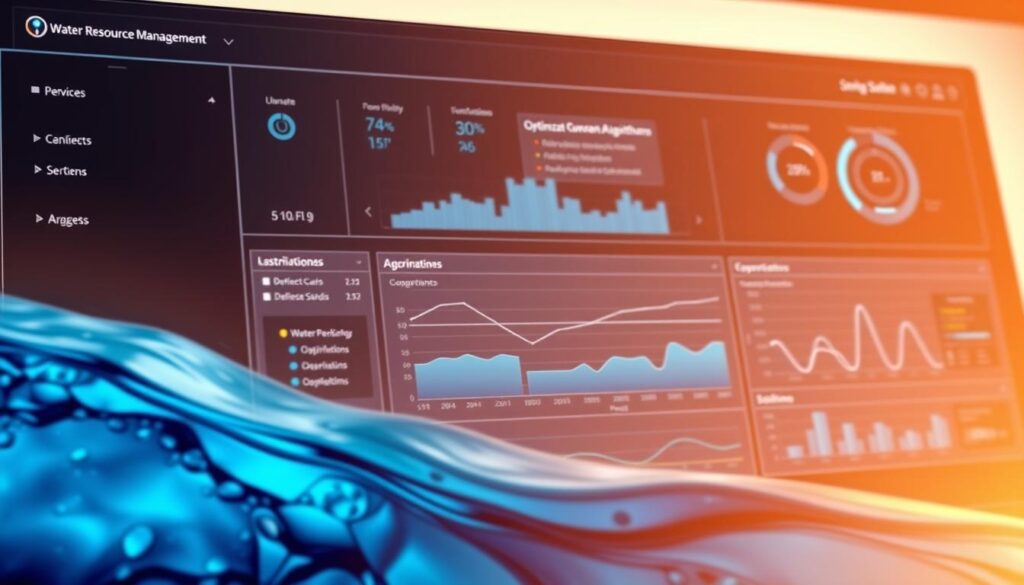
Industry-specific water engineering solutions are revolutionizing how various sectors manage their water resources. The water resources management software market has seen significant growth, driven by the need for efficient and tailored solutions across different industries.
Agricultural Water Management Tools
Agricultural water management is a critical aspect of water engineering, given the significant water requirements of the agricultural sector. Specialized tools and software are being used to optimize water use, reduce waste, and improve crop yields. For instance, water industry solutions are being adopted to enhance agricultural water management practices.
These tools often incorporate advanced technologies such as IoT sensors and data analytics to provide insights into soil moisture levels, crop water requirements, and irrigation scheduling. By leveraging these technologies, farmers can make informed decisions to optimize water use and reduce environmental impact.
Stormwater Management Software
Stormwater management is another critical area where industry-specific solutions are making a significant impact. Urbanization has led to increased runoff, posing challenges for cities in managing stormwater effectively. Advanced software solutions are being used to model stormwater systems, predict flood risks, and design effective mitigation measures.
These software tools often integrate with GIS systems to provide a comprehensive understanding of stormwater dynamics. By analyzing data on rainfall patterns, land use, and drainage infrastructure, cities can develop more effective stormwater management strategies.
Wastewater Treatment Software
Wastewater treatment is a vital component of water engineering, ensuring that wastewater is treated effectively before being discharged into the environment. Specialized software is being used to optimize wastewater treatment processes, improve effluent quality, and reduce energy consumption.
These software solutions often employ advanced algorithms and modeling techniques to simulate wastewater treatment processes and identify areas for improvement. By optimizing treatment processes, wastewater treatment plants can reduce operational costs and minimize environmental impact.
Case Studies: Successful Implementations
Successful implementations of water system design software have transformed the way municipalities manage water supply and mitigate flood risks. By leveraging advanced software tools, professionals in the field have been able to design more efficient systems and respond more effectively to challenges.
Municipal Water Supply Management
One of the critical areas where water engineering software has made a significant impact is in municipal water supply management. For instance, the use of such software has enabled municipalities to optimize their water distribution networks, reducing waste and improving supply consistency. Case studies have shown that these implementations lead to more reliable water services for communities.
The software allows for detailed modeling and simulation of water distribution systems, enabling engineers to identify potential issues before they become major problems. This proactive approach not only saves costs but also enhances the overall quality of service.
Innovative Flood Control Solutions
In addition to improving water supply management, water engineering software has also been pivotal in developing innovative flood control solutions. By accurately modeling flood scenarios, municipalities can design and implement more effective flood mitigation measures, protecting communities from the devastating impacts of flooding.
These software tools provide critical insights into flood dynamics, allowing for the design of targeted interventions that reduce risk and enhance resilience. The result is a significant reduction in the economic and human impacts of flooding, contributing to safer and more sustainable communities.
Through these case studies, it’s clear that water system design software is a vital component in the successful management of water resources, offering both immediate benefits and long-term strategic advantages.
Challenges in Water Engineering Software Adoption
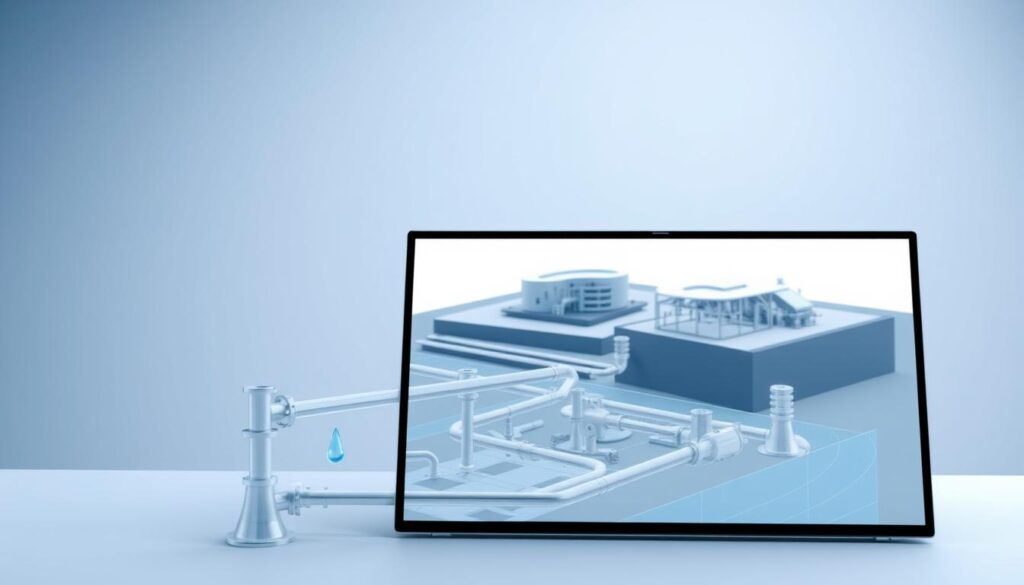
The integration of water engineering software tools is often hindered by several key challenges. As organizations strive to leverage technology for improved water management, they must navigate issues that can impede successful adoption.
Data Security Concerns
One of the primary challenges is data security concerns. Water engineering software often handles sensitive data related to water infrastructure, making it a potential target for cyber threats. Ensuring the security of this data is paramount.
To mitigate these risks, organizations can implement robust security measures, such as encryption and secure access controls. Regular audits and compliance with industry standards can also enhance data security.
Resistance to Change in Organizations
Another significant challenge is resistance to change within organizations. Employees may be accustomed to traditional methods and hesitant to adopt new software, potentially disrupting workflows.
To overcome this resistance, organizations should invest in comprehensive training programs that highlight the benefits of the new software. Change management strategies, including clear communication and support, can also facilitate a smoother transition.
| Challenge | Impact | Mitigation Strategy |
|---|---|---|
| Data Security Concerns | Potential data breaches | Implement encryption and access controls |
| Resistance to Change | Disrupted workflows | Comprehensive training and change management |
For more insights on overcoming challenges in water engineering, visit this resource on innovative approaches in water management.
Future of Water Engineering Software
Water engineering software is on the cusp of a new era, driven by advancements in technology and changing industry needs. As professionals in the field, it’s essential to stay ahead of the curve by understanding the potential developments that will shape the industry.
Predictions for Technological Advancements
The future of water engineering software will likely be characterized by significant technological advancements. One of the key areas of development is expected to be in wastewater modeling tools, which will become more sophisticated, allowing for more accurate predictions and simulations.
Another area of growth is anticipated to be in the integration of artificial intelligence (AI) and machine learning (ML) into water engineering software. This will enable professionals to analyze complex data sets more efficiently and make informed decisions.
Importance of Adaptability in the Industry
As water engineering software continues to evolve, the importance of adaptability in the industry cannot be overstated. Professionals will need to be flexible and open to adopting new technologies and methodologies to remain relevant.
The ability to adapt will also be crucial in addressing the emerging challenges in water management, such as climate change and population growth. By embracing new technologies and approaches, the industry can ensure that it is equipped to meet these challenges head-on.
In conclusion, the future of water engineering software holds much promise, driven by technological advancements and the need for adaptability. By staying informed and embracing change, professionals in the field can look forward to a more efficient, effective, and sustainable future.
Tips for Choosing the Right Water Engineering Software
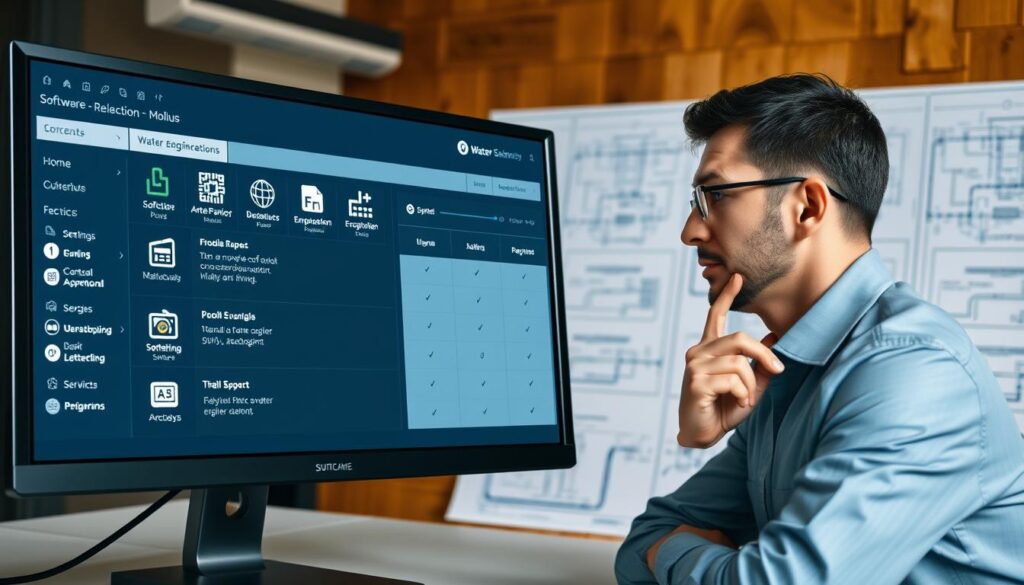
The process of choosing the right water engineering software involves several key considerations that can make or break a project. Professionals in this field must navigate a complex landscape of options, each with its unique features and benefits.
Assessing Project Needs
Before selecting a water engineering software, it’s crucial to assess the specific needs of your project. This includes understanding the type of analysis required, the scale of the project, and any specific features needed, such as hydraulic modeling software for complex water distribution systems.
For instance, if your project involves designing a water treatment plant, you may require water treatment plant design software that can handle detailed design and simulation tasks. Evaluating these needs upfront can help narrow down your software options.
Seeking Feedback from Peers
One of the most valuable resources when choosing water engineering software is feedback from peers and industry colleagues. Consulting with others who have used the software can provide insights into its strengths and weaknesses.
For more detailed guidance on selecting the right tools, you can refer to resources like selecting the right Modflow solver package, which offers expert advice on making informed decisions.
Setting a Budget
Establishing a budget is another critical step in the software selection process. Water engineering software can range from relatively affordable to very costly, depending on its capabilities and the scale of the project it is intended for.
When setting a budget, consider not only the initial cost of the software but also ongoing expenses such as maintenance, updates, and training. A comprehensive budget analysis can help ensure that the chosen software is not only effective but also cost-efficient.
| Software Feature | Importance | Cost Consideration |
|---|---|---|
| Hydraulic Modeling | High | $$ |
| Water Treatment Design | Medium | $ |
| GIS Integration | High | $$$ |
By carefully assessing project needs, seeking feedback from peers, and setting a realistic budget, professionals can make informed decisions when choosing water engineering software. This thoughtful approach can lead to better project outcomes and increased efficiency.
Training and Certification for Water Engineering Software
The rapidly evolving field of water engineering software necessitates continuous learning and professional development. As new technologies and methodologies emerge, professionals must stay updated to remain proficient in using these tools effectively.
Importance of Ongoing Training
Ongoing training is crucial for maximizing the benefits of water engineering software tools. It enables professionals to:
- Stay current with the latest features and updates
- Enhance their skills in data analysis and interpretation
- Improve their ability to integrate software tools with other systems, such as GIS
By investing in ongoing training, professionals can ensure that they are using hydrological analysis tools to their full potential, leading to more accurate and efficient project outcomes.
Available Certification Programs
Several certification programs are available for professionals looking to demonstrate their expertise in water engineering software. For example, the American Water Works Association (AWWA) eLearning Course offers a range of courses and certifications in water management and engineering.
Some key benefits of certification programs include:
- Enhanced credibility and recognition within the industry
- Improved job prospects and career advancement opportunities
- Demonstrated commitment to staying current with industry developments
By combining ongoing training with certification programs, professionals can stay at the forefront of water engineering software and maintain a competitive edge in their field.
Conclusion: Selecting Effective Water Engineering Software
Effective water engineering software is crucial for professionals in the field, enabling them to design, manage, and maintain water infrastructure efficiently. The right software can significantly enhance project outcomes by improving accuracy, reducing costs, and facilitating collaboration.
Key Takeaways
The key to selecting the appropriate water resources management software or water infrastructure design software lies in understanding the specific needs of the project, evaluating the features and capabilities of various tools, and considering factors such as technical support, cost, and user reviews.
Staying Ahead in the Field
As the field of water engineering continues to evolve, it’s essential for professionals to stay updated with the latest advancements in software technology. Embracing continuous learning and adaptation will enable water engineering professionals to leverage the full potential of water engineering software, driving innovation and excellence in their work.
